Intermediate forsythia: description of varieties, planting and care rules

After the winter period, any area looks empty and gray. However, in some areas, you can find a bright shrub - this is forsythia in the flowering phase. The unusualness of this representative of the flora lies in the fact that it becomes covered with buds before the foliage grows on other plants.


Peculiarities
Intermediate forsythia combines some types of shrubs and trees. Today, there are more than 100 varieties of this plant. Among the population, another name for this culture is known - golden lilac. Under natural conditions, intermediate forsythia can be found everywhere. The description of the shrub indicates that this is a plant of medium size and short stature. Often its height reaches from 100 to 300 centimeters. The branches on the culture are drooping, and the leaves are oval.
Golden lilac flowers are characterized by a variety of shapes, their color is usually rich yellow.



Varieties
The spreading shrub looks quite impressive and original. Gardeners can choose from a wide variety of intermediate forsythia to decorate their backyard. The most popular varieties of culture.
- Linwood Gold. The height of forsythia of this variety reaches from 250 to 300 centimeters. The crown of the plant is spreading, dense. The buds of the culture have a bright yellow color, however, closer to autumn, the plates turn purple. The foliage is jagged and elongated. The flower of "Lynwood Gold" is large, its diameter can be 3 centimeters. The plant blooms profusely, usually this phase occurs at the end of May.

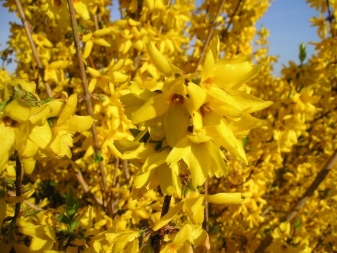
- "Spectabilis" Is a large and dense bush with drooping branches and abundant flowering. The shrub is resistant to diseases and pests. Large jagged leaves in autumn have a yellow and purple tint. Numerous yellow flowers are located along the entire shoot.


- Golden Time - one of the tall intermediate forsythia hybrids, which can grow up to 300 centimeters. The crown of the plant is characterized by a diameter of 200 centimeters. The flowering period of the culture falls in early spring, at which time yellow flowers appear on the shrub. The decorativeness of the golden lilac of this variety lies in the unusual elongated foliage with a bright green center and a wide yellow border around the edge. The variety is considered winter hardy.


- "Minigold". Forsythia of this variety is characterized by low growth, but at the same time extremely spreading branches. Blooming buds are dark yellow in color. In autumn, the leaves are characterized by decorativeness, as they have an unusual violet-yellow hue.
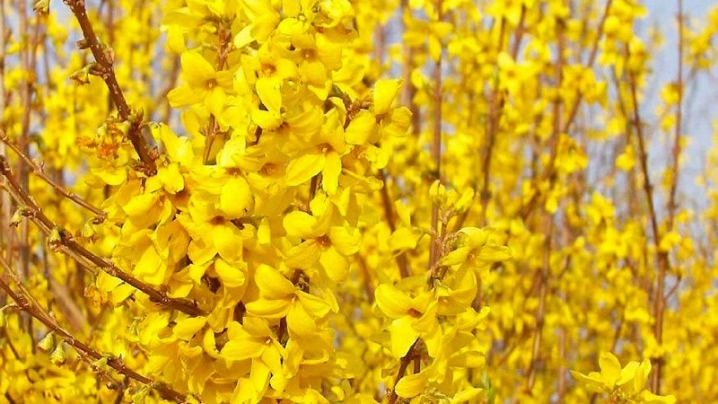
- Goldsauber refers to ornamental shrubs that attract attention with their golden yellow bell-shaped flowers. The height of the spreading crop is 200 centimeters. The branches of the plant grow straight, the bark has a light shade of brown. The foliage is characterized by an ovate-lanceolate shape and up to 10 centimeters long. The flowering period is usually around 20 days. The fruits of the culture are presented in the form of a cracking box.

- Spring Glory. The bush can grow up to 3 meters tall, adding 30 centimeters annually. The plant is wide, bushy, has dense hanging shoots. Ovate leaves are colored green, they remain on forsythia for a long time. The bud contains light yellow flowers that have a diameter of 35 millimeters.The culture is classified as abundantly flowering, this phase occurs in April-May.


- "Weekend" presented in the form of a bush with a height of 250 centimeters. The crown of the plant has a columnar type. The stem of the crop is brown. The buds are densely covered with golden lilacs. The flowering period comes in April-May. The leaves are colored light green, sometimes green. The variety belongs to frost-resistant, light-requiring.

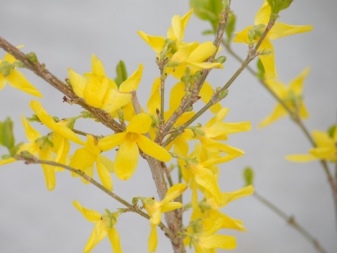
- "Malukh" - a low-growing forsythia, reaching a height of only 100 cm. The flat, spherical bush is characterized by lush early flowering (it occurs in April). The flowers are yellow, their diameter is 1.5-2 cm.

Landing
It is necessary to plant and transplant golden lilacs at the beginning of the spring period or in the fall, before the arrival of frost. Thus, the culture will be able to take root before the onset of winter. The site for planting intermediate forsythia should be protected from wind penetration. The place should be located in a sunny or semi-shaded area, despite the fact that the plant is shade-tolerant, it loves the sun very much. Golden lilac is undemanding to the nature of the soil; light alkaline dry soil is considered the best option for it. Given the high acidity of the soil, the situation will be corrected by digging up the soil and adding wood ash to it.
The gardener needs to dig a planting hole with dimensions of 0.5x0.5x0.6 meters, after planting the root system should be at a depth of 0.4 meters. When planting several crops, it is worth keeping a distance of 150 centimeters between them. Immediately before planting at the bottom of the hole, it is worth pouring a 15-centimeter drainage, which can include crushed stone or broken brick. Next, 10 centimeters of sand is poured, after which the mixture is in the form of leafy earth, sand, peat, as well as 0.3 kilograms of sod land. The forsythia seedling must be lowered into the prepared hole, sprinkled with soil and compacted. At the end of the procedure, it is worthwhile to carry out abundant irrigation.
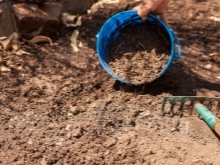

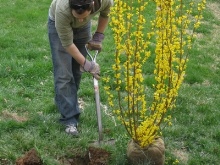
Care
No special care for golden lilacs is required. If precipitation often fell in the summer, then there is no need to water the shrub. Under the condition of dry weather, it is required to irrigate the plant every few months, pouring 12 liters of water under the bush. When the irrigation is over, you can start loosening the circle near the trunk, removing weeds. The next step is to mulch with compost or dry soil.
It is required to feed intermediate forsythia 3 times per season. In the first spring days, near the trunk circle, it is required to decompose the rotted manure in the form of a thick layer. After this procedure, abundant irrigation is required. In this case, manure acts as mulch and organic feed. In April, shrubs need to apply a full range of mineral fertilizers in the amount of 60 g per m2.
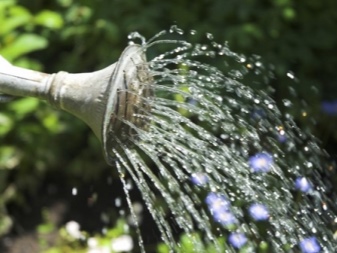

At the end of the flowering phase and the laying of flower buds, golden lilacs need to be fed with the help of "Kemira-wagon", while for 1 sq. meter will be enough 100 grams of substance. When pruning a young individual, it requires removing dry, broken and frozen branches. Adult forsythia are cut off shoots that died during the winter. The main activities for cutting the branches of golden lilacs are carried out in the summer, after flowering.
Branches that have faded should be shortened in half, and obsolete and dried-up ones should be cut off 0.06 meters from the ground level. This procedure promotes the growth of new shoots. Thanks to pruning, you can adjust the height of the crop as well as its shape.
To prevent the loss of decorativeness, it is worth rejuvenating the culture once every 3-4 years.


To protect the hybrid bush from frostbite buds, it should be covered for the cold season. For this purpose, it is recommended to use pine spruce branches, fallen leaves and cut grass. To do this, it is worth buying a nonwoven material, which is sold in a specialty store.The use of polyethylene will prevent air penetration and promote the development of putrefactive processes.
Intermediate forsythia refers to plants that are resistant to diseases and pest attacks. Only a young, immature representative can attract ailments. Fusarium is considered a common ailment of golden lilac. In this case, the plant wilts, the appearance of a black plaque on the trunk, which looks like mold.
The use of "Fitosporin", "Trichophyte" or another drug with a similar effect can save the culture.



There are known cases of attacks by shrubs with moniliosis. The disease can be recognized by the appearance of dry brown spots on the branches and leaves of the plant. It may immediately seem that a representative of the flora received severe burns. To cure forsythia, it is worth using fungicides.
As for parasites, the culture is most often attacked by aphids and nematodes. Specialized folk remedies will help get rid of them. If a large number of pests appear, it is worth using good quality insecticides. It does not take much time, effort and skills to grow an unusual bright plant. Forsythia intermediate can grow and bloom in various conditions, while it can do without care measures. This culture is often used in landscape design to decorate a garden or suburban area.

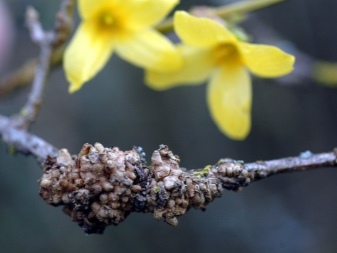
Golden lilac is an unpretentious representative of olive trees. Each of the gardeners can choose for themselves the look that they like. This plant begins its flowering phase in the first days of spring. For this reason, the culture is used for planting in different flower arrangements. This bush looks harmonious with a single, group planting, it can become a bright spot against the background of coniferous vegetation.
This representative of the flora looks advantageous in hedges, when decorating borders, as a decoration on the balcony and terrace. Often, intermediate forsythia is grown in pots and used as part of a beautiful bouquet.
Today, a large number of varieties of this plant are known, which can be easily planted and grown on your site.
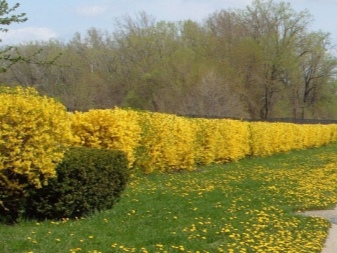

In the next video, planting, care, cultivation and reproduction of forsythia are waiting for you.







































































































The comment was sent successfully.